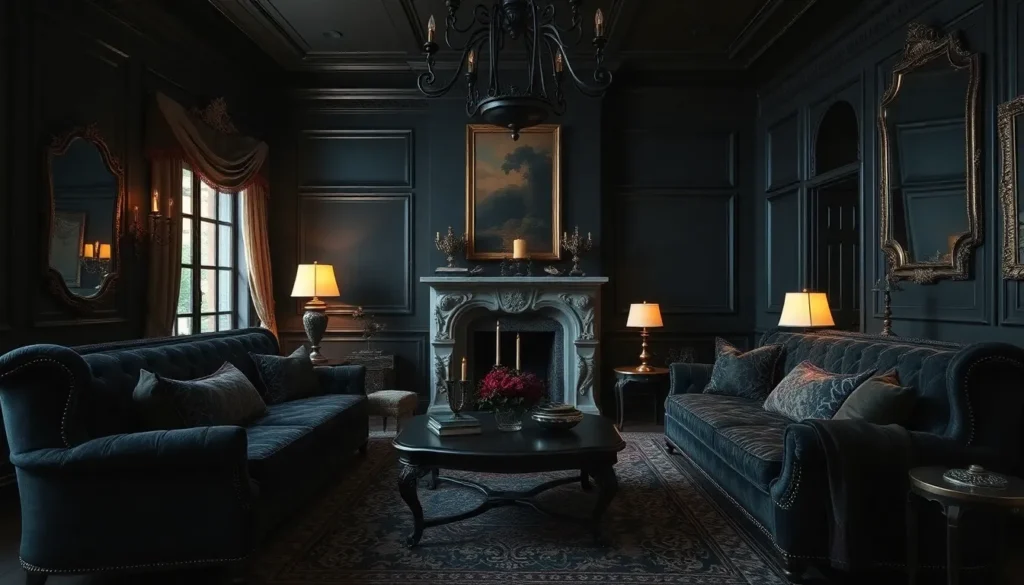We’ve all felt the magnetic pull of gothic aesthetics – that perfect blend of dramatic elegance and mysterious charm that transforms ordinary spaces into captivating sanctuaries. Gothic living rooms aren’t just about dark colors and heavy furniture; they’re sophisticated spaces that celebrate rich textures, ornate details, and timeless architectural elements that create an atmosphere of refined drama.
Today’s gothic interior design has evolved far beyond medieval stereotypes. We’re seeing homeowners embrace this bold style through luxurious velvet furnishings, intricate metalwork, and carefully curated antiques that tell compelling stories. The key lies in balancing darkness with strategic lighting and incorporating modern comfort into classic gothic elements.
Whether you’re drawn to subtle gothic touches or ready to fully commit to this enchanting aesthetic, we’ll guide you through creating a living room that’s both hauntingly beautiful and surprisingly livable. Get ready to discover how gothic design can transform your space into something truly extraordinary.
Create a Dark and Dramatic Color Palette
Building your gothic living room’s visual foundation requires selecting colors that evoke mystery and sophistication. We recommend starting with a strategic approach to dark hues that creates depth without overwhelming the space.
Choose Deep Jewel Tones as Your Foundation
Deep emerald greens anchor your gothic palette with their rich, velvety appearance that mirrors the gemstones found in Victorian jewelry. We suggest painting accent walls in forest green or incorporating emerald velvet sofas as statement pieces that command attention. Burgundy wine shades add warmth and luxury to your space, working beautifully on upholstered chairs or heavy curtains that frame tall windows.
Sapphire blues create dramatic focal points when used on built-in bookcases or ornate ceiling details. We’ve found that midnight blue works exceptionally well in larger living rooms where you want to create intimate conversation areas. Royal purple accents through throw pillows, artwork, or decorative objects introduce an air of nobility that perfectly complements gothic aesthetics.
Amethyst purples bridge the gap between your blues and reds, creating visual harmony throughout the room. We recommend using deep plum tones sparingly on smaller furniture pieces like ottomans or side tables to avoid color saturation.
Incorporate Rich Blacks and Charcoal Grays
True black serves as your gothic living room’s most powerful tool for creating drama and defining architectural features. We suggest using matte black paint on fireplace surrounds, window trim, or exposed ceiling beams to emphasize structural elements. Glossy black works beautifully on furniture pieces like coffee tables, picture frames, or decorative accessories that catch and reflect light.
Charcoal grays provide sophisticated transitions between your darkest blacks and jewel tones without creating harsh contrasts. We recommend charcoal for larger wall surfaces where pure black might feel too intense, especially in rooms with limited natural light. Medium gray tones work well for upholstery on larger pieces like sectional sofas or armchairs.
Slate grays add subtle texture variations when used on textured surfaces like stone mantels, brick accent walls, or rough-hewn wooden furniture pieces. We’ve discovered that layering different gray tones creates visual depth that prevents your gothic space from appearing flat or one-dimensional.
Add Metallic Accents in Silver and Gold
Silver metallics enhance your gothic palette’s cool undertones while adding reflective surfaces that brighten darker spaces. We recommend incorporating brushed silver through lighting fixtures like candelabras, floor lamps with ornate bases, or decorative mirrors with elaborate frames. Pewter finishes on hardware, picture frames, or decorative bowls create subtle metallic touches without overwhelming your color scheme.
Antique gold accents warm up your gothic living room while maintaining the luxurious feel essential to this aesthetic. We suggest using aged brass or bronze finishes on larger statement pieces like ornate mirrors, vintage-style light fixtures, or decorative fireplace tools. Gold leaf details on picture frames, furniture trim, or architectural molding add opulent touches that catch candlelight beautifully.
Copper tones bridge warm and cool metallics while adding an aged patina that enhances your gothic atmosphere. We recommend copper accents through decorative vessels, vintage-style light fixtures, or small sculptural objects that complement your deeper color palette without competing for attention.
Select Statement Gothic Furniture Pieces
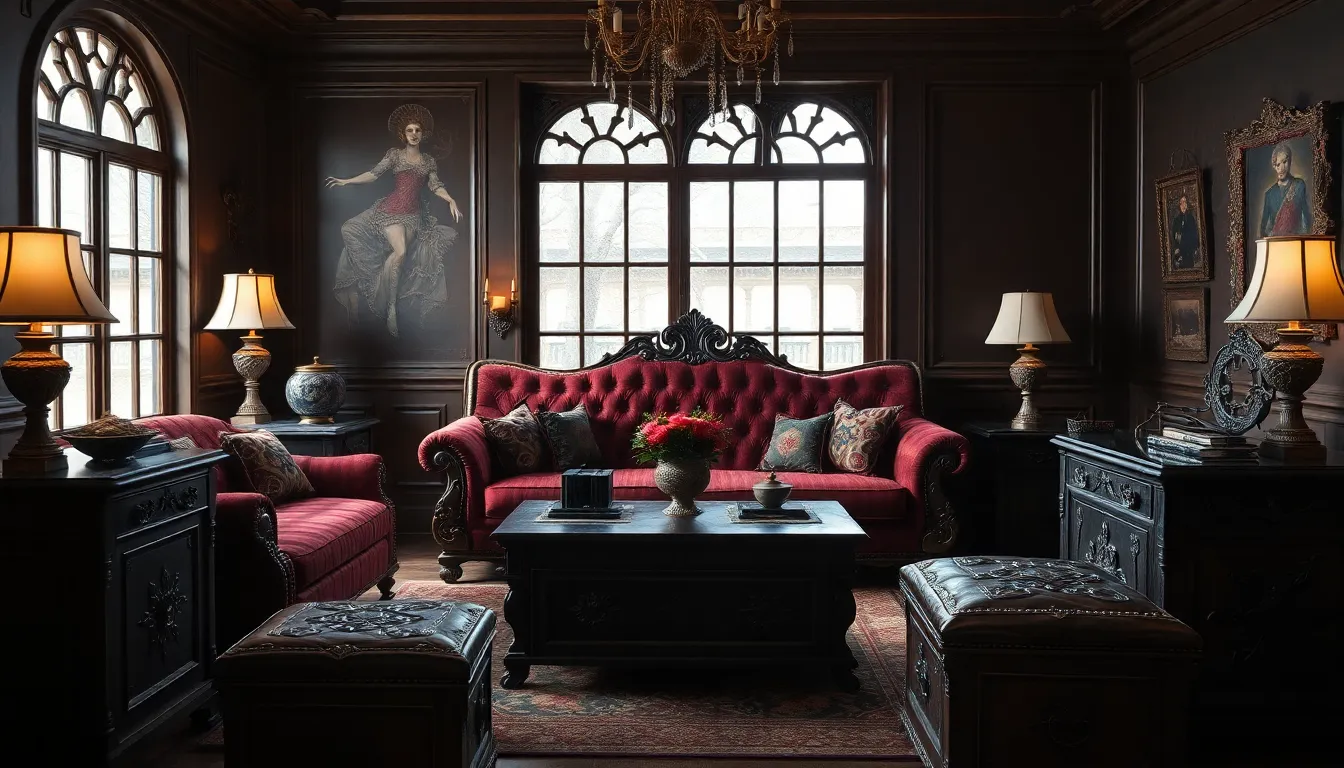
Gothic furniture transforms living spaces with bold architectural elements and luxurious materials. Statement pieces become focal points that anchor the room’s dramatic aesthetic while providing functional beauty.
Invest in Ornate Victorian-Style Seating
Intricately upholstered chairs bring Victorian elegance to gothic living rooms through elaborate detailing and ornate craftsmanship. These pieces feature rich fabrics like velvet or brocade in deep jewel tones, creating visual drama while maintaining comfort for daily use.
Tufted furniture enhances the gothic atmosphere with deep, mysterious colors such as burgundy, emerald green, or midnight blue. Button tufting adds texture and dimension to sofas and armchairs, creating shadows that play beautifully with gothic lighting schemes.
Ornate velvet sofas serve as commanding centerpieces in plush, luxurious fabrics that invite both relaxation and admiration. We recommend selecting pieces with carved wooden frames or metal studs to amplify the gothic aesthetic while ensuring seating remains inviting for guests.
Choose Dark Wood Tables with Intricate Carvings
Dark wood accents create mysterious, shadowed atmospheres through tables and shelves crafted from rich materials. These pieces often showcase pointed arch motifs, gargoyle details, or cathedral-inspired elements that directly reference gothic architectural heritage.
Walnut or oak woods provide the perfect dark tones that complement gothic color schemes naturally. Their deep grain patterns add visual interest even before considering the intricate carvings that make each piece unique.
Carved wood coffee tables become conversation starters with elaborate designs featuring gothic cathedral elements or mythical creatures. These functional art pieces ground seating areas while displaying books, candles, or decorative objects that enhance the room’s dramatic narrative.
Add Antique or Vintage Storage Answers
Antique armoires introduce historical depth and mystery to gothic living spaces through their imposing presence and weathered patina. These towering pieces provide essential storage while serving as dramatic backdrops for displaying gothic accessories or hiding modern electronics.
Vintage trunks function as both coffee tables and storage units, adding nostalgic intrigue to seating arrangements. We love how these pieces spark curiosity about their past while providing practical answers for storing blankets, books, or seasonal decorations.
Storage chests with metal hardware and aged finishes create focal points that blend functionality with gothic storytelling. These pieces work beautifully as accent tables or window seating while concealing everyday items that might disrupt the room’s carefully curated atmosphere.
Install Dramatic Gothic Lighting Fixtures

Lighting transforms our gothic living room from ordinary to extraordinary, creating the mysterious atmosphere that defines this captivating style. We’ll explore three essential lighting approaches that evoke the grandeur of ancient cathedrals while maintaining modern functionality.
Hang Wrought Iron Chandeliers as Focal Points
Wrought iron chandeliers command attention as stunning centerpieces that instantly elevate our gothic living room’s dramatic appeal. These fixtures feature intricate detailing that echoes the architectural elements found in Gothic cathedrals, bringing a regal ambiance to our space. Complex metalwork patterns, twisted iron branches, and ornate scrollwork create visual interest that draws the eye upward.
Position these statement pieces above seating areas or dining spaces to maximize their impact as focal points. Select chandeliers with multiple tiers or candle-style bulbs to enhance the medieval aesthetic we’re cultivating. Dark bronze or black iron finishes complement our established color palette while maintaining authenticity to traditional gothic design principles.
Use Candelabras and Lantern-Style Table Lamps
Candelabras add an authentic medieval touch that connects our modern gothic living room to its historical roots. These elegant pieces create warm, mysterious illumination reminiscent of ancient grand halls where flickering flames once provided the only source of light. Place ornate candelabras on mantels, side tables, or console surfaces to establish multiple points of ambient lighting throughout the room.
Lantern-style table lamps complement candelabras by providing practical task lighting with gothic flair. Choose lamps featuring wrought iron frames, stained glass panels, or parchment shades that filter light softly. These fixtures bridge the gap between decorative elements and functional lighting needs while maintaining our room’s cohesive aesthetic.
Create Ambient Lighting with Dimmable Wall Sconces
Dimmable wall sconces provide the soft, ambient lighting that enhances our gothic living room’s cozy and mystical atmosphere. These fixtures offer precise control over lighting levels, allowing us to adjust the mood from bright and welcoming to dim and mysterious depending on the occasion. Install sconces at strategic locations along walls to eliminate harsh shadows while creating layers of illumination.
Choose wall sconces with gothic-inspired details such as wrought iron brackets, frosted glass shades, or medieval torch designs. Mount them at eye level or slightly higher to cast light both upward and downward, creating interesting shadow patterns on textured walls. Consider sconces with warm-toned LED bulbs that mimic candlelight for the most authentic gothic ambiance.
Incorporate Gothic Architectural Elements
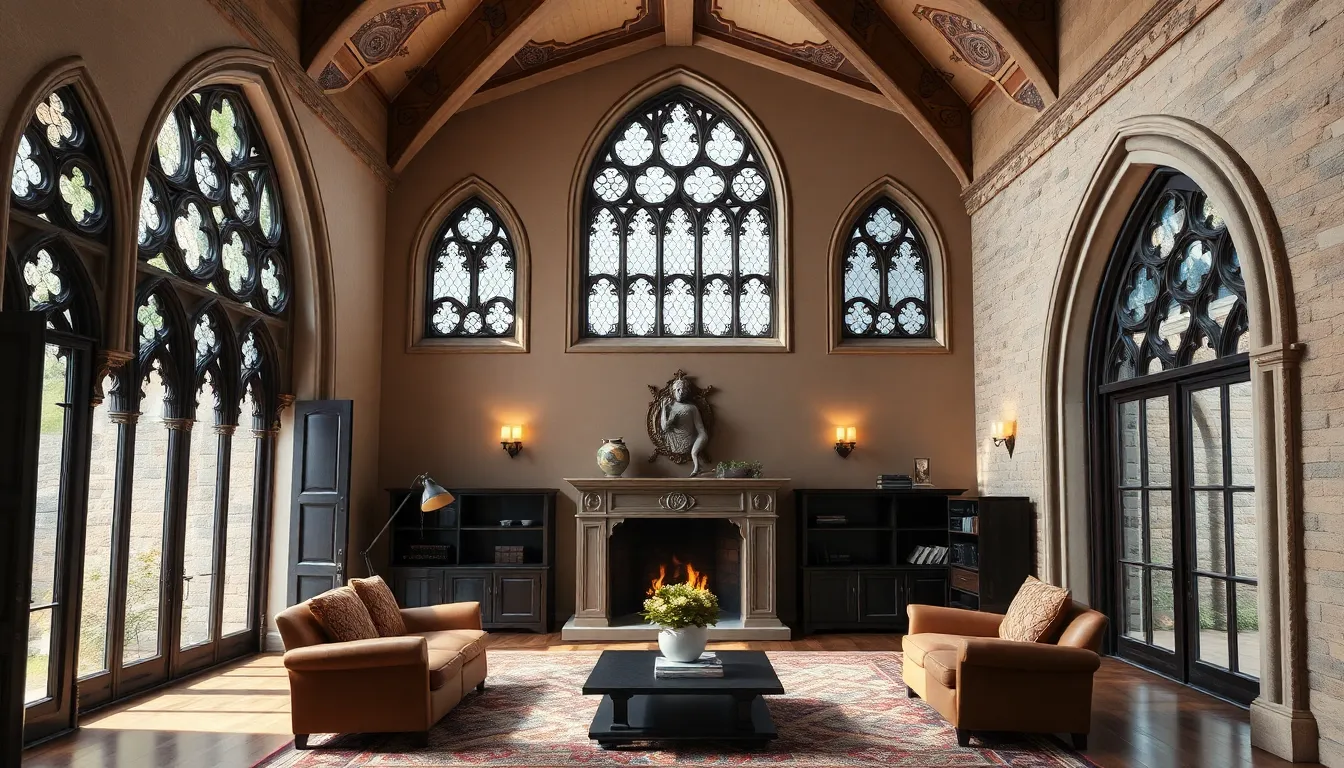
Gothic living room design reaches its full potential when we integrate authentic architectural elements that capture the essence of medieval grandeur. These structural features transform ordinary spaces into dramatic sanctuaries reminiscent of ancient cathedrals and castles.
Add Pointed Arch Doorways and Windows
Pointed arch doorways instantly establish the iconic Gothic silhouette that defines this timeless aesthetic. We can install custom archway frames over existing rectangular doorways to create the illusion of medieval cathedral entrances. Windows benefit from similar treatment through decorative arch overlays or custom framing that mimics the soaring lines of Gothic architecture.
Converting standard doorways involves adding curved wooden or plaster arch elements that extend the opening’s visual height. Professional contractors can create permanent structural changes, while DIY enthusiasts might opt for decorative arch frames that attach to existing openings. Window treatments should complement these arched elements with flowing curtains or stained glass panels that echo the cathedral aesthetic.
Install Crown Molding with Medieval-Inspired Details
Crown molding with intricate medieval motifs adds sophisticated architectural depth to gothic living rooms. We recommend selecting molding profiles that feature quatrefoil patterns, trefoil designs, or carved stone-like details that mirror Gothic cathedral ornamentation. These elaborate trim pieces create visual connections between walls and ceilings while establishing the room’s historical character.
Installation requires careful attention to corner joints and pattern alignment to maintain the molding’s ornate appearance. Skilled craftspeople can create custom molding pieces that incorporate exact Gothic symbols or family crests for personalized touches. Painting these elements in contrasting colors like deep bronze or aged gold highlights their intricate details against darker wall colors.
Create Feature Walls with Stone or Brick Textures
Feature walls with stone or brick textures simulate the massive masonry construction that characterizes authentic Gothic architecture. We can achieve these effects through various methods, from installing real stone veneer to applying textured wallpapers that convincingly replicate ancient stonework. Exposed brick walls work exceptionally well in rooms with existing masonry, while faux finishing techniques can transform smooth drywall into convincing stone surfaces.
Natural stone options include limestone, sandstone, or slate that create authentic medieval castle atmospheres. Manufactured stone veneer provides lighter weight alternatives with consistent coloring and easier installation. Brick textures work particularly well as accent walls behind seating areas or fireplaces, where their rough surfaces contrast beautifully with luxurious gothic furnishings and soft lighting fixtures.
Choose Luxurious Gothic Textiles and Fabrics
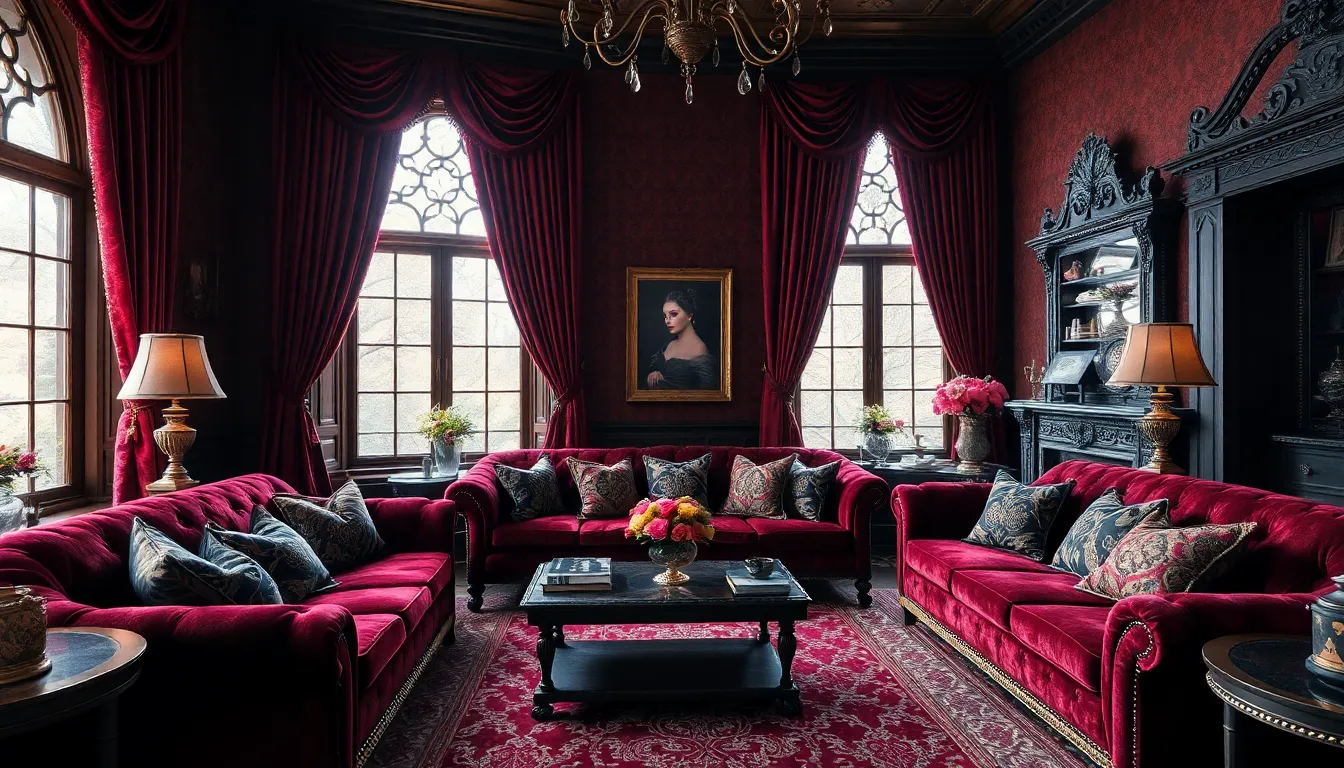
Textiles form the foundation of any authentic gothic living room design. We’ll transform your space through carefully selected fabrics that capture the opulent drama essential to gothic aesthetics.
Select Velvet and Brocade Upholstery
Velvet upholstery creates the ultimate gothic seating experience with its rich texture and luxurious appeal. We recommend choosing sofas and chairs in deep velvet fabrics like burgundy, midnight blue, or forest green to establish your room’s dramatic foundation. Brocade fabrics offer intricate woven patterns that enhance the medieval atmosphere while providing sophisticated comfort.
These materials naturally complement the gothic color palette while adding the tactile luxury that makes gothic interiors so captivating. Velvet’s light absorbing qualities create depth and mystery, while brocade’s ornate patterns echo the detailed craftsmanship found in gothic architecture. Both fabrics age beautifully and develop character over time, making them perfect investments for your gothic living space.
Layer Heavy Drapery in Deep Colors
Heavy drapery in burgundy, emerald green, or navy blue transforms windows into dramatic focal points that enhance your gothic atmosphere. We suggest selecting curtains with substantial weight and rich texture to create the mysterious ambiance gothic rooms require. These deep colors filter natural light beautifully while maintaining privacy and intimacy.
Ornate patterns and decorative tassels elevate simple drapery into statement pieces worthy of medieval grandeur. The layering effect creates visual depth while softening harsh architectural lines. Heavy fabrics also provide excellent sound dampening, creating the hushed, reverent atmosphere characteristic of gothic spaces.
Add Gothic Pattern Throw Pillows and Blankets
Gothic pattern throw pillows featuring quatrefoils, fleur de lis, or gargoyle motifs instantly transform ordinary seating into medieval inspired furniture. We recommend mixing different gothic patterns while maintaining your established color scheme for visual interest without overwhelming the space. These decorative elements add mystery and elegance while providing comfortable functionality.
Luxurious blankets in silk, lace, or additional velvet create layered textures that invite touch and enhance the room’s opulent feel. Pattern combinations work best when you vary the scale, pairing large architectural motifs with smaller repeated designs. These accessories allow you to introduce gothic elements gradually while maintaining flexibility to update your decor seasonally.
Display Gothic Art and Decorative Accessories

Gothic art and decorative accessories transform your living space into a sanctuary of mystery and elegance. These carefully curated pieces serve as the finishing touches that elevate your gothic living room from simply dark to dramatically sophisticated.
Hang Dark Romantic Paintings and Portraits
Dark romantic paintings create an atmosphere of mystery and opulence that captures the essence of Gothic literature and architecture. We recommend selecting portraits with haunting expressions or landscapes shrouded in mist to evoke the dramatic storytelling tradition of gothic art. Medieval scenes depicted in tapestries add historical depth and narrative richness to your walls, transforming them into conversation pieces that transport viewers to another era.
Position these artworks at eye level to maximize their impact, and consider grouping smaller pieces together to create a gallery wall effect. Oil paintings with heavy, ornate frames work particularly well in gothic spaces, as they reflect the craftsmanship and attention to detail characteristic of the medieval period. Choose pieces that feature deep, moody colors like burgundy, forest green, and midnight blue to maintain harmony with your overall color palette.
Showcase Ornate Mirrors with Elaborate Frames
Ornate mirrors with elaborate frames serve as both functional elements and stunning decorative focal points in gothic living rooms. We suggest selecting mirrors featuring pointed arches, quatrefoil motifs, or intricate carved details that echo the architectural elements of Gothic cathedrals. These pieces reflect light throughout darker spaces while adding visual interest and depth to your walls.
Metallic accents in gold, bronze, or aged silver enhance the sophisticated ambiance and complement other gothic elements in your room. Position large ornate mirrors opposite windows to maximize natural light reflection, or use smaller decorative mirrors in groupings to create visual rhythm along a wall. Antique or vintage mirrors with weathered frames add authentic character, while reproduction pieces offer the same aesthetic appeal with modern reliability.
Arrange Skull Motifs and Medieval Inspired Decor
Skull motifs introduce a touch of macabre mystery when incorporated subtly through carefully selected decorative accessories. We recommend using skull bookends, decorative boxes, or small sculptural pieces rather than overwhelming displays that might feel theatrical rather than sophisticated. These elements should complement rather than dominate your gothic living room design.
Medieval inspired decor pieces like candelabras, ornate chandeliers, and gargoyle adorned accessories evoke the grandeur of Gothic cathedrals while maintaining livability. Wrought iron candelabras with authentic medieval styling provide both ambient lighting and decorative appeal, while small gargoyle statues or architectural fragments add historical authenticity. Choose pieces with detailed craftsmanship that showcase the intricate stonework and metalwork traditions of the medieval period.
Add Natural Gothic Elements

Natural elements bridge the gap between gothic grandeur and organic beauty, creating spaces that feel both dramatic and authentically grounded.
Incorporate Dried Flowers and Dark Botanicals
Dried flowers and dark botanicals transform our gothic living room into a hauntingly elegant sanctuary. Black roses, dried eucalyptus, and deep-hued foliage create texture while maintaining the mysterious atmosphere we’re cultivating. We can arrange these botanical elements in ornate vases or antique containers to preserve the gothic theme throughout our space.
These timeless botanicals complement dark color palettes beautifully, introducing natural beauty without compromising our room’s dramatic aesthetic. Positioning dried arrangements on mantels, side tables, or gothic-inspired pedestals adds visual interest at varying heights. The weathered textures of dried elements echo the aged quality we see in authentic gothic architecture.
Use Weathered Stone and Metal Accents
Weathered stone and aged metal accents mirror the architectural grandeur of gothic cathedrals in our living space. Stone-effect wall panels create authentic gothic atmosphere while wrought iron light fixtures add dramatic shadows and architectural interest. We can incorporate metal candle holders, decorative grilles, and stone bookends as practical yet atmospheric design elements.
These materials contribute depth and authenticity to our gothic aesthetic through their weathered, time-worn appearance. Metal sconces provide ambient lighting while reinforcing the medieval atmosphere we’re creating. Stone accents work particularly well as feature elements, whether through textured wall treatments or carefully placed decorative objects.
Display Antique Books and Leather-Bound Collections
Antique books and leather-bound collections serve as signature gothic decor that reinforces intellectual sophistication. We can arrange these volumes on shelves, coffee tables, or within glass-front cabinets to create focal points throughout our space. These collections add historical depth while contributing to the classic gothic aesthetic we’re developing.
Pairing leather-bound books with gothic-inspired bookends creates an opulent display that speaks to the scholarly traditions of medieval times. The rich textures and aged patinas of antique volumes complement our dark color palette naturally. Stacking books at varying heights on surfaces adds visual rhythm while maintaining the mysterious, learned atmosphere characteristic of gothic design.
Create Gothic Focal Points and Conversation Areas
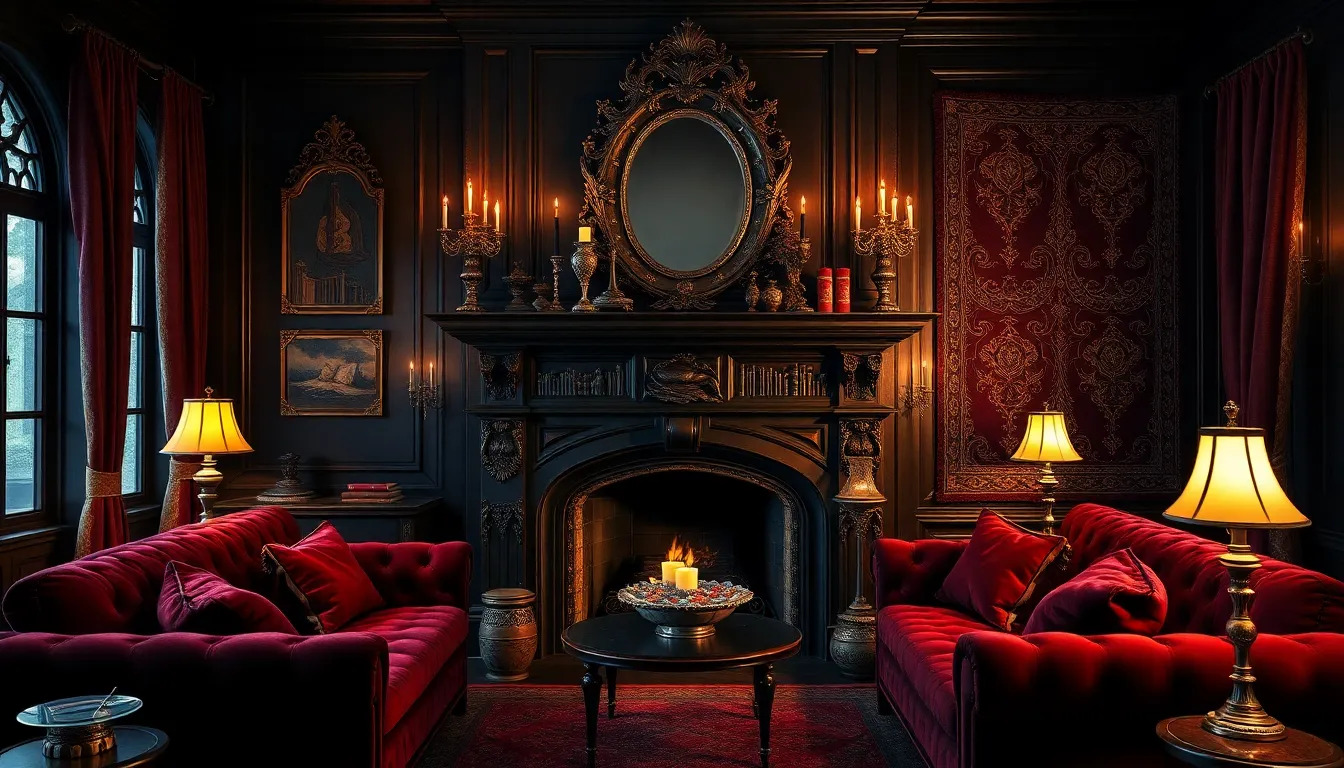
Transforming your living room into a gothic sanctuary requires strategic placement of statement pieces that command attention. We’ll show you how to create dramatic focal points and intimate conversation areas that embody the sophisticated mystery of gothic design.
Design a Dramatic Fireplace Mantel Display
Architectural elements reminiscent of Gothic cathedrals elevate your mantel into a commanding centerpiece. Pointed arches carved from dark wood or crafted from wrought iron frame the fireplace opening with cathedral-inspired grandeur. Gargoyle sculptures positioned at each end of the mantel add protective symbolism while maintaining authentic medieval character.
Candelabras create ambiance reminiscent of grand castle halls when arranged in varying heights across the mantel surface. Gothic metalwork in bronze or blackened steel provides the perfect foundation for pillar candles that cast flickering shadows against the wall. Decorative tapestries hung above the mantel showcase intricate medieval patterns in rich burgundy and gold tones.
Ornate mirrors with elaborate Gothic frames reflect candlelight throughout the room while doubling the visual impact of your display. Stone-effect panels behind the fireplace simulate massive masonry construction typical of Gothic architecture. Antique brass accents and wrought iron details complete the authentic cathedral aesthetic.
Arrange Intimate Seating Around Dark Coffee Tables
Dark palettes in black, charcoal, dark green, or dark plum create intimate conversation areas that invite guests to linger. Coffee tables crafted from ebony or mahogany with intricate carvings serve as commanding centerpieces surrounded by plush seating. Velvet sofas in deep jewel tones create a regal atmosphere while maintaining the sophisticated gothic aesthetic.
Layered lighting from table lamps or floor lamps enhances the cozy, mysterious feel of intimate seating arrangements. Wrought iron lamp bases with burgundy or deep green shades provide task lighting while maintaining gothic flair. Strategic placement of candles in ornate holders adds warmth without overwhelming the space.
Ornate furnishings with intricate carvings and luxurious finishes create conversation areas that feel both dramatic and inviting. Carved wood coffee tables featuring gothic motifs anchor seating groups while providing surfaces for decorative objects. Rich textures from brocade cushions and velvet throws add comfort to dark wooden chairs with high backs.
Establish Reading Nooks with Gothic Atmosphere
Soft lighting from vintage-style lamps sets the perfect mood for gothic reading retreats tucked into corners or bay windows. Lantern-style table lamps with amber glass panels cast warm pools of light over leather-bound books and manuscripts. Dimmable wall sconces allow you to adjust the ambiance from bright task lighting to mysterious shadows.
Intricate patterns on richly textured blankets and pillows featuring iconic gothic motifs create depth and visual charm in reading areas. Tapestry cushions displaying medieval scenes provide comfortable seating while reinforcing the historical aesthetic. Fur throws in dark colors add luxurious warmth during long reading sessions.
Antique storage answers like carved wooden bookcases and leather-bound collections create authentic gothic reading environments. Weathered stone bookends shaped like gargoyles or medieval knights add functional decoration to shelves. High-backed chairs upholstered in dark velvet provide comfortable seating that feels appropriately throne-like for your gothic retreat.
Balance Gothic Elements with Modern Comfort
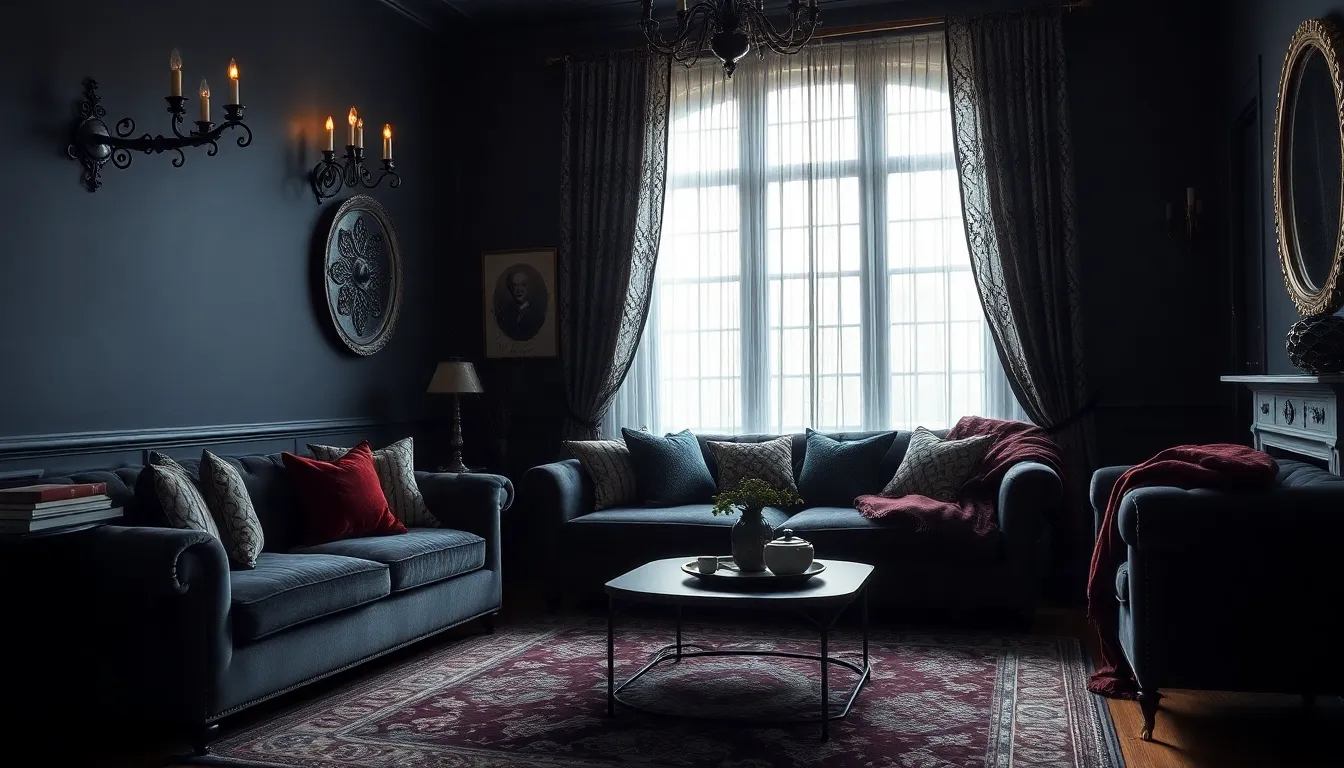
Achieving the perfect gothic living room means thoughtfully combining dramatic medieval aesthetics with contemporary livability. We’ll explore how to create spaces that honor gothic traditions while meeting modern comfort standards.
Maintain Functionality While Embracing Dark Aesthetics
Dark color palettes form the foundation of authentic gothic design, featuring rich blacks, charcoal grays, deep greens, and dark plums that create dramatic atmospheres. Strategic lighting placement becomes essential when working with these darker hues, ensuring spaces remain functional for daily activities like reading, entertaining, and relaxation.
Table lamps with vintage designs provide focused task lighting while maintaining gothic authenticity through ornate metalwork and aged finishes. Floor lamps with soft fabric shades diffuse warm ambient light throughout the room, preventing dark corners from becoming oppressive or unusable.
Layered lighting systems work best in gothic spaces, combining multiple light sources at different heights to create depth and visual interest. Vintage-style sconces mounted on walls can illuminate exact areas while adding authentic gothic architectural details that enhance the overall aesthetic.
Ensure Adequate Natural Light Sources
Natural light enhancement transforms gothic living rooms from potentially oppressive spaces into dramatically beautiful environments with striking shadow play. Window treatments become crucial design elements that filter daylight while maintaining the mysterious gothic ambiance we’re creating.
Spider web lace curtains offer intricate filtering that creates eerie yet elegant light patterns across dark surfaces throughout the day. Heavy velvet drapes in deep jewel tones can frame windows dramatically while allowing controlled amounts of natural light to enter when needed.
Reflective metallic accents in gold and bronze help bounce available natural light around the room, brightening dark spaces without compromising the gothic aesthetic. Strategic mirror placement near windows amplifies natural light while ornate gothic frames add authentic decorative elements that enhance the overall design theme.
Create Cozy Spaces Within the Gothic Theme
Texture layering transforms potentially cold gothic elements into inviting, comfortable spaces where we can relax and unwind. Richly patterned blankets featuring iconic gothic motifs like damask, brocade, or medieval-inspired designs add warmth while reinforcing the aesthetic theme.
Cotton accent pieces provide soft, breathable comfort that balances heavier gothic furnishings without disrupting the dark sanctuary atmosphere. Plush area rugs in deep colors ground seating areas while adding essential softness underfoot for daily comfort.
Velvet throw pillows with intricate carvings or metallic threading create luxurious comfort zones on sofas and chairs. Statement furniture pieces like tufted ottomans or carved wooden side tables provide both functional surfaces and authentic gothic design elements that enhance the cozy atmosphere we’re building.
Conclusion
Creating your dream gothic living room isn’t about following strict rules—it’s about embracing the romance of darkness while maintaining the warmth of home. We’ve shown you how strategic design choices can transform any space into a sophisticated sanctuary that feels both dramatic and inviting.
The key lies in finding your personal balance between gothic grandeur and everyday comfort. Whether you’re drawn to ornate Victorian pieces or prefer subtle nods to medieval architecture every element should reflect your unique vision.
Your gothic living room awaits—let these ideas inspire you to create a space that’s hauntingly beautiful and unmistakably yours.
Frequently Asked Questions
What is gothic interior design and how does it differ from just using dark colors?
Gothic interior design is a sophisticated aesthetic that goes beyond dark colors to incorporate rich textures, ornate details, and timeless architectural elements. It features luxurious materials like velvet, intricate metalwork, curated antiques, and strategic lighting that creates depth and visual interest rather than simply painting everything black.
What color palette works best for a gothic living room?
A gothic living room thrives on dark, dramatic colors that evoke mystery and sophistication. Use deep jewel tones like emerald, burgundy, and sapphire alongside rich blacks. Incorporate metallic accents in silver, gold, and copper to add reflective surfaces that brighten darker spaces and create visual depth.
What type of furniture should I choose for a gothic living room?
Select statement pieces with intricate details such as Victorian-style seating with ornate upholstery, tufted furniture with rich fabrics, and antique storage solutions. Look for furniture with carved details, dark wood finishes, and luxurious materials like velvet or leather that add historical depth and authentic gothic character.
How important is lighting in gothic interior design?
Lighting is essential for gothic design success. Use dramatic fixtures like wrought iron chandeliers and candelabras for authentic medieval ambiance. Layer different lighting sources including vintage-style lamps to create depth and prevent dark colors from becoming oppressive. Strategic placement ensures functionality while maintaining the mysterious atmosphere.
What architectural elements can enhance a gothic living room?
Incorporate pointed arch doorways, feature walls with stone or brick textures, and dramatic ceiling details. Consider adding gothic-inspired moldings, arched windows, or architectural salvage pieces. These elements create authentic gothic character and provide the structural foundation that makes the overall design cohesive and impactful.
How can I create focal points in my gothic living room?
Design dramatic focal points through strategic placement of statement pieces like an ornate fireplace mantel with pointed arches, gargoyle sculptures, and candelabras. Create intimate conversation areas around dark coffee tables, establish cozy reading nooks with vintage lamps, and use architectural elements as natural gathering points.
What textiles and fabrics work best for gothic decor?
Choose luxurious, richly textured fabrics like velvet, brocade, and heavy cotton. Layer patterned blankets, plush area rugs, and ornate throw pillows. Dark romantic fabrics with intricate patterns add depth and comfort while maintaining the gothic aesthetic. Focus on materials that feel substantial and add tactile interest.
How do I balance gothic elements with modern comfort?
Ensure functionality by incorporating comfortable seating with gothic styling, adequate lighting for daily activities, and practical storage solutions with ornate details. Use strategic lighting placement and maintain some natural light sources. Layer textures thoughtfully and choose pieces that serve both aesthetic and practical purposes without compromising the gothic atmosphere.
What decorative accessories complement gothic interior design?
Include dark romantic paintings, ornate mirrors with intricate frames, gargoyle sculptures, and candelabras. Add natural gothic elements like dried flowers, antique books, and vintage collectibles. Choose accessories with historical significance, metalwork details, and rich textures that enhance the mysterious atmosphere without cluttering the space.
Can I incorporate natural light in a gothic living room design?
Yes, natural light is important to prevent gothic spaces from feeling oppressive. Use strategic window treatments that filter light while maintaining privacy. Balance natural light with layered artificial lighting to create depth. The contrast between light and shadow enhances the dramatic gothic aesthetic while ensuring the space remains livable and welcoming.

